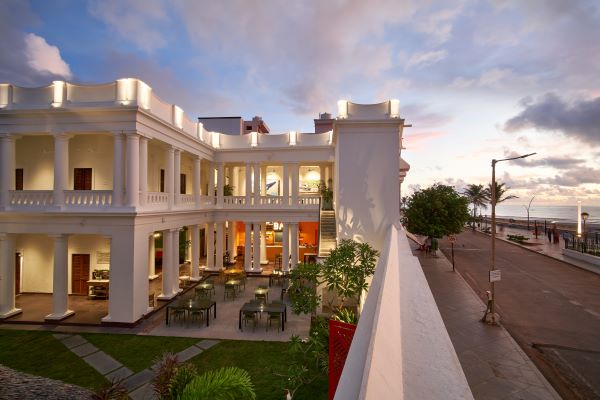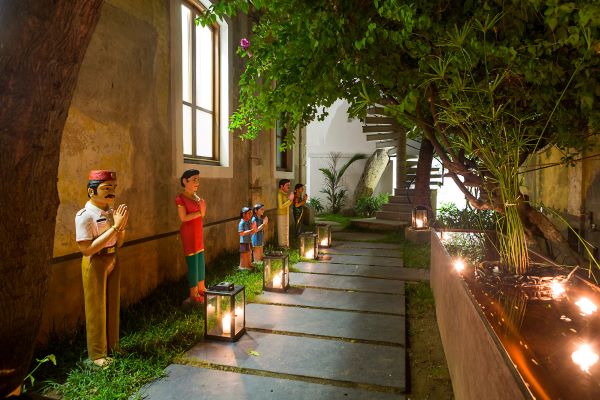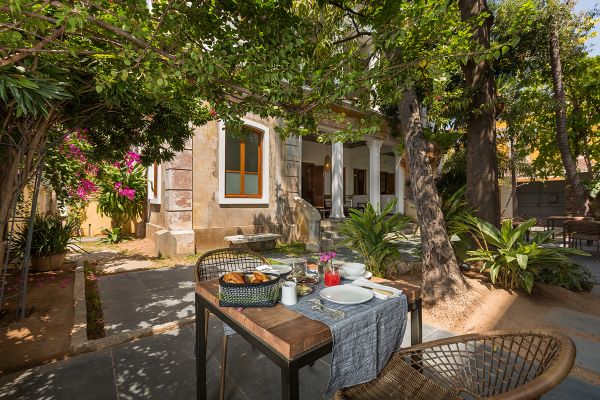Explore the rich fusion of flavors and cultures as we delve into an insightful interview with Segiyane-Sylvain Paquiry, the visionary behind Villa Shanti, LA VILLA and THE SPOT in Pondicherry with a unique perspective on the Indo-French relationship as seen through the lens of this renowned establishment.

Entrepreneur in regenerative hotels and restaurants - Foreign French trade advisor chez CCE Inde - Président Alumni lycée Français International Pondicherry.
Segiyane-Sylvain Paquiry: I belong to the French-Pondicherry community. My grandparents were French, having been born in Pondicherry during its time as a French colony. Many French individuals from Pondicherry had the opportunity to work in administration in France and all of the French colonies at the time. Many of them after retiring from the Ministry of the Armed Forces returned to Pondicherry. My grandfather and father did exactly that.
My father left Pondicherry at the age of 18 to join the Ministry of the Armed Forces, then returned to Pondicherry to marry before returning to France, where I was born, along with my brother and two sisters. I entered the Lycée Français de Pondicherry, now the Lycée Français International de Pondicherry, in sixth grade. I received my Baccalaureate there.
After the BaccaIaureate, I didn’t know what to do so I chose a “BTS Commerce International” ( International Trade course ) from the ONISEP catalog just because the word “international” sounded good. However I was not interested at all by these studies and at the end of the second year, searching for a challenge and a desire to travel, I signed up for two years of military service in Polynesia. At the end of my service, the Ministry of Defense in Polynesia offered me the chance to stay and work as a civilian in the Ministry, with a good salary and a very interesting job.
However, once my military service was completed, I realized that working in tourism, rather than import-export, would be a better fit for me because I enjoy traveling. Furthermore, with my parents in India, I decided that traveling from France to meet them would be easier than traveling from Polynesia.
I chose to follow my studies in the form of a work-study program and I was recruited by a Chinese travel operator called “China Travel Service.” I learned about the requirements of a commercial company. I work in the outbound division and as such was planning excursions and accompanying customers to China.
My next goal was to work for a French tour operator that specialized in India, so I applied to the “Le Monde de l’Inde” ( India World) travel agency.
This time in addition to China, I was in charge of building and selling itineraries to French tourists in India, Laos, Burma, Cambodia, Iran, Nepal, and Uzbekistan. Realizing that even though tourism was booming in the 1990s, there was a lack of accommodation for tourists, I proposed to my shareholders that they invest with me in India, to develop an accommodation and catering project in Pondicherry.
In 2006, with the agency’s shareholders, we identified a historic haveli to repair in the Shekhawati region (Rajasthan), but cultural and social biases discouraged me and convinced me that Pondicherry was the place to do it.
By coincidence, I discovered a guest house for rent in Pondicherry and immediately signed a 25-year lease. Thus, we started the “Villa Shanti” project with my partners.
The entrepreneurial journey began. I founded a company and met the Parisian architects Yves Lesprit and Tina Trigala, who renovated while preserving the original essence of many cinemas, notably the “Cinema des Cinéastes” in Place de Clichy (France), as well as building hotels in Africa and Greece. I was immediately convinced by their approach to the “reuse of heritage”.
Segiyane-Sylvain Paquiry: It was thanks to Yves Lesprit and Tina Trigala that I discovered this concept. When it comes to construction, heritage reuse entails changing the use of a structure while keeping its original essence. Historical history is therefore protected. In this approach, it is possible to avoid the demolition spiral, which frequently opens the road to indefinable architecture or even misinterpretation of historic architecture. Villa Shanti was converted from a private residence into a 15-room hotel with a restaurant while retaining and modernizing the original architecture and furnishings.
Following the Villa Shanti, a friend who owned the former mansion of the Lycée Français principals was pleased by Villa Shanti’s makeover and requested me to come up with a plan for this historic property dating from the end of the 19th century.
I signed a 22-year lease and collaborated once more with Yves Lesprit and Tina Trigala to adorn La Villa in keeping with its heritage. As a result, “La Villa” was created, a hotel with six suites, a restaurant, and a swimming pool. Later on, Yves and Tina became my partners.
Travel & Leisure magazine named LA VILLA the Best New Hotel in 2015.
In 2017, to showcase French gastronomy, I invited French Michelin-starred chef, Michel Christmann to join our company.
Together we applied the concept of reuse. In this case, it’s a way of highlighting the local culinary heritage. Why should we import Scottish salmon when we have an excellent local sear fish? Why should we forget the memory of the “Terroir”? For example, we use millet (which requires less water than rice) for our custard, we use tandoor to cook steamed vegetables in a European way.
We also participate in a local initiative (Local Food System) for all the food products we use in the kitchen, and are trying to move towards 0 waste. We wish to
With the ever-growing flow of popular restaurants, each with its style, we invested in an old embroidery center called “l’Atelier au fil d’Indra” founded in 1971 by two women, Nicole Durieux and Marie José Carlié and we opened a central kitchen, an hostels for our staff. We are also keen in a near future to revive this wonderful embroidery center with the help of the former president Mr François Casimir.
Segiyane-Sylvain Paquiry: The Colombani family donated the Maison Colombani building to the Alliance française in 1987.
L’Alliance Française wanted to create in this House an Annex to Alliance Française that would be an instrument for Franco-Indian cooperation. After several unsuccessful attempts to imagine a cultural project and create an artist’s residence, director Gérard Greverand decided to launch a call for tenders and lease the building to a recognized operator. We won the tender for Maison Colombani and “The Spot” was born. The Spot is a multi-purpose space where you can have a drink or a coffee, have lunch or dinner, listen to a concert, have a meeting, watch an exhibition, or support local artisans by buying unique creations in the contemporary crafts store.
Segiyane-Sylvain Paquiry: In India, we find great vital energy, a positively destabilizing matrix, no routine, and a meaning to life.
You have to be patient and believe in the long term. You also need to keep a close eye on legislative developments as the country becomes more structured. It’s often difficult to keep up with changing legislation, and easy to get caught up in day-to-day priorities. Laws don’t immediately reach our level and can be contradictory. So, it’s important to stay informed and get advice on how to comply with regulations. it’s important to surround yourself with competent specialists who can support an entrepreneur who doesn’t have the time to keep up with changing legislation, or the patience to deal with local authorities.
Segiyane-Sylvain Paquiry: Apart from the major areas of industrial excellence in which France excels, such as Aerospace and Automobile, I can say that in Pondicherry, France enjoys an excellent image, particularly among the upper middle class. But France needs to work on a frugal innovation or “jugaad” in Hindi, to appeal to all classes (particularly in urban planning and architecture). Indian tourists come to Pondicherry for a taste of France, its values, its education, the French art of living, architecture, design, literature, and, of course, its gastronomy.
Segiyane-Sylvain Paquiry: As President of the Alumni Association of the Lycée Français International de Pondicherry, I would say that it is truly an open book to France, a witness to the social elevator, the cement of a whole community of French or French-speaking-people united around universal values and humanism. In addition to training employees, our institution trains men and women who respect deep-rooted values and have sensitivity to understand the challenges of a multicultural world.
Founded in 1826 it is a bridge between India and France, East and West, therefore a real asset for young Indians.
Apart from the Lycée Français in Pondicherry, there are still a dozen Indian schools with a French curriculum. There’s the Sri Aurobindo Ashram, with its strong ties to France, and the international town of Auroville, also strongly influenced by the vision of a Frenchwoman Mira Alfassa.
I encourage French academic institutions and companies to establish themselves in Pondicherry and throughout India, as well as French firms to invest in India. The quality of life in Pondicherry is significantly superior to that of any megalopolis, and its cosmopolitan nature is a significant benefit.
Let’s hope that Pondicherry’s application to become a UNESCO World Heritage Site will soon be accepted.



For more information on this portrait or on UJA contact olivia@uja.in
